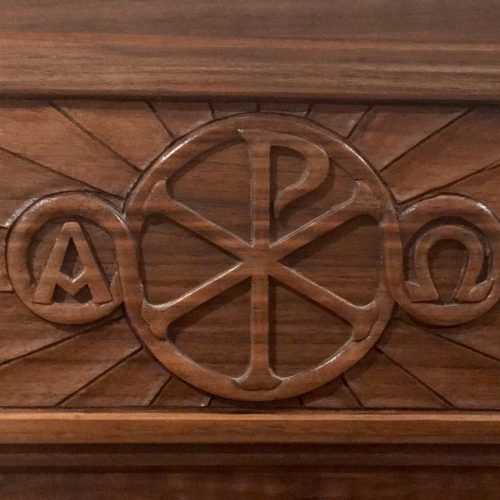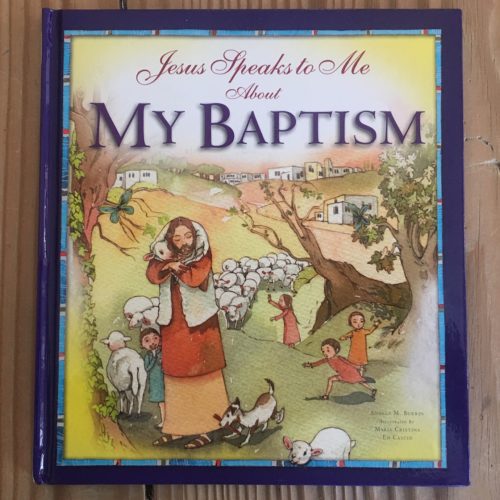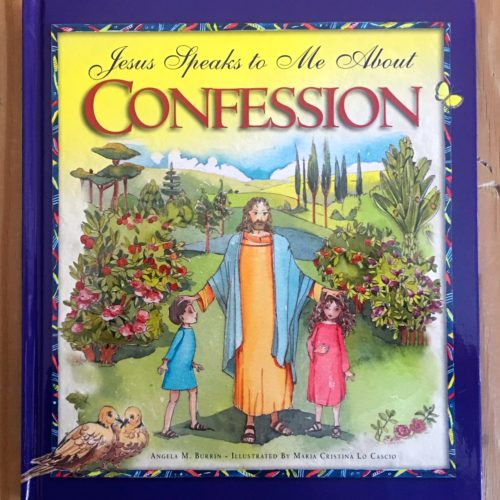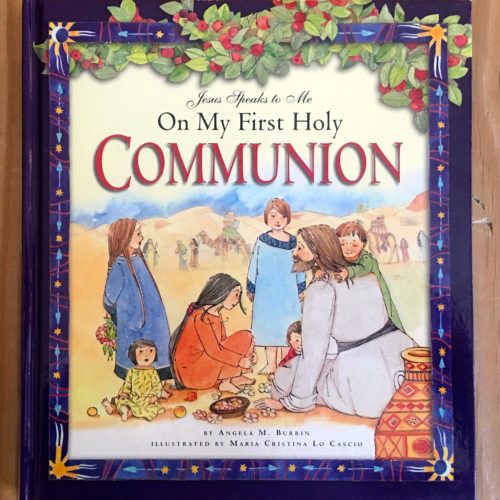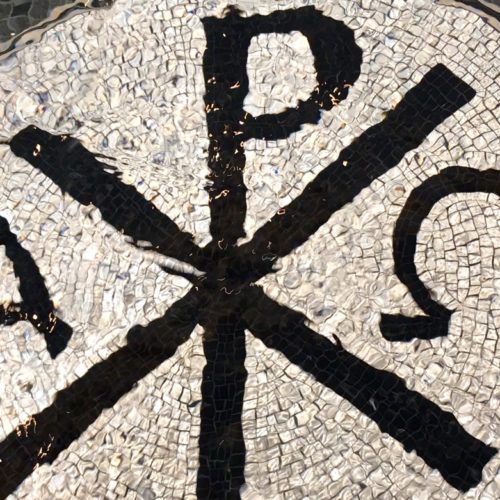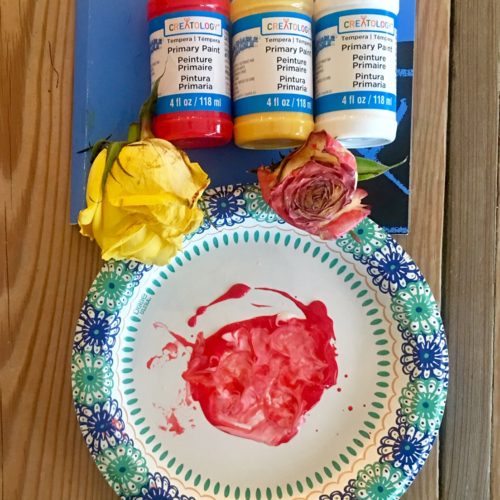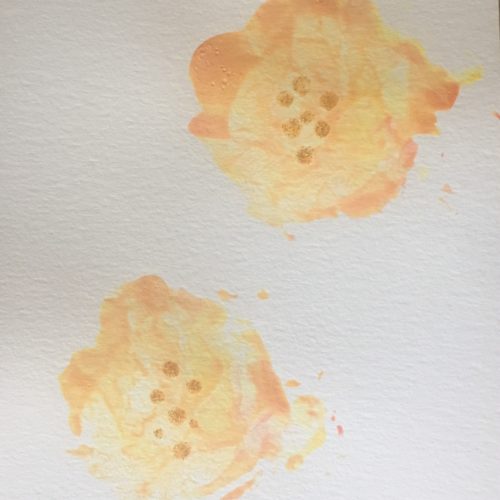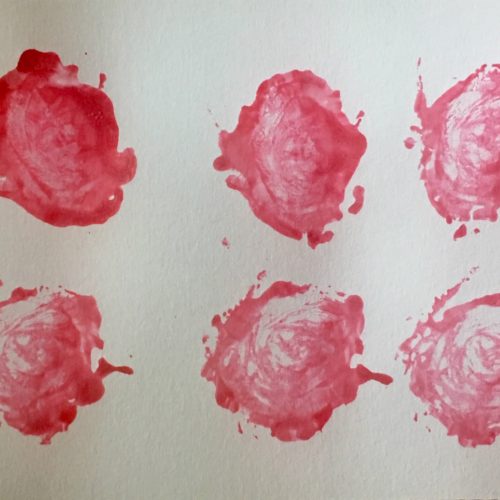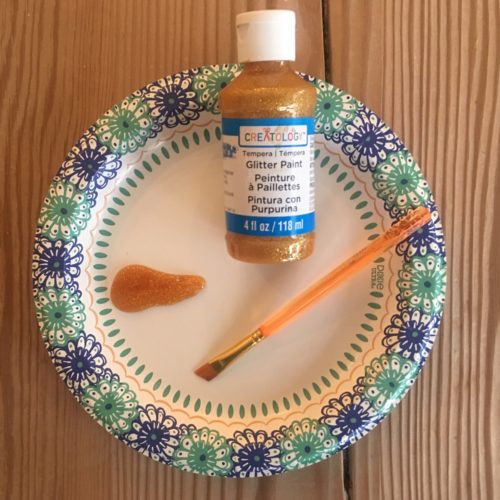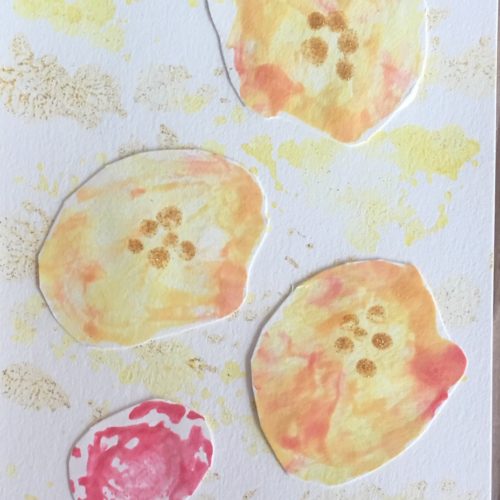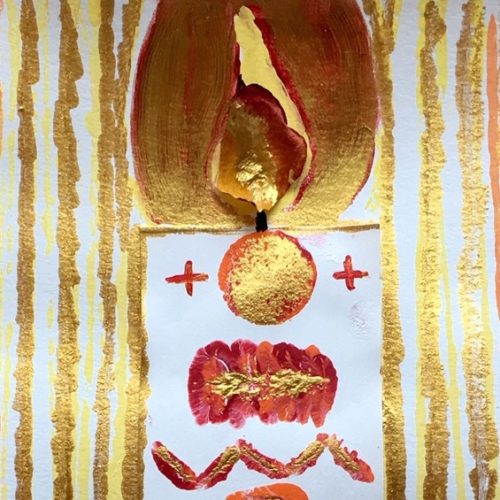“After all the people had been baptized and Jesus also had been baptized and was praying, heaven was opened, and the holy Spirit descended upon him in bodily form like a dove. And a voice came from heaven, ‘You are my beloved Son; with you I am well pleased.’”
Source: USCCB.org Luke, chapter 3:21-22
Our Art Gallery
John, chapter 8:12
“I am the light of the World.”
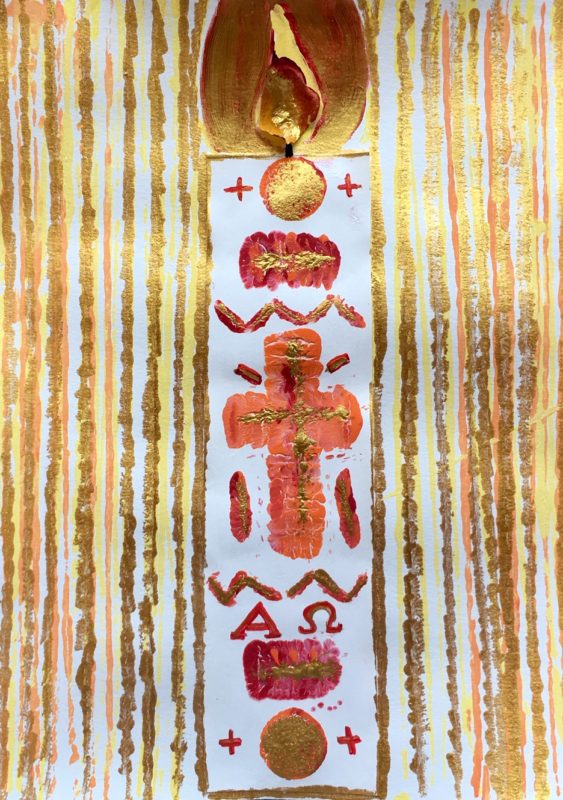
“The Paschal candle represents Christ, the Light of the World.
The pure beeswax of which the candle is made represents the sinless Christ who was formed in the womb of His Mother. The wick signifies His humanity, the flame, His Divine Nature, both soul and body.
Five grains of incense inserted into the candle in the form of a cross recall the aromatic spices with which His Sacred Body was prepared for the tomb, and of the five wounds in His hands, feet, and side.
During the Easter Vigil on Holy Saturday night the priest or deacon carries the candle in procession into the dark church. A new fire, symbolizing our eternal life in Christ, is kindled which lights the candle. The candle, representing Christ himself, is blessed by the priest who then inscribes in it a cross, the first letters and last of the Greek alphabet, (Alpha and Omega `the beginning and the end’) and the current year, as he chants the prayer below; then affixes the five grains of incense.
The Easter candle is lighted each day during Mass throughout the Paschal season until Ascension Thursday.”
Source: CatholicNewsAgency.com
For Parents to Teach to Their Children
Hello Parents, this week we are looking at the Sacrament of Baptism, as the children prepare for the Sacrament of First Reconciliation. I stepped back for a second to think about how I’d talk to the students about Baptism as they are practicing and memorizing “An Act of Contrition” in anticipation of their first confession. Since all the children in my class were baptized as infants or young children, it’s as if Baptism is over and done with. Baptism is the open door for a person to be able to receive the Sacraments of Initiation–Baptism, Confirmation, and the Eucharist –and become a part of Christ and a part of the Church. As their lives unfold, through Baptism, they will be able to receive God’s Grace through the Sacraments of Marriage, Holy Orders, and Anointing of the Sick; and, the ability to “grow in grace.” The reading below is an excellent review of the meaning and importance to Baptism in the Catholic Church. I found it very helpful.
Source: Richert, Scott P. “The Sacrament of Baptism in the Catholic Church.” Learn Religions, Aug. 22, 2019, learnreligions.com/the-sacrament-of-baptism-542130.
Reading For Parents About Baptism From, “The Catechism of the Catholic Church”
Source: USCCB.org
“A Resource for Peaching and Teaching About the Sacraments” Pages 7-8
“Baptism, Confirmation, and Eucharist are the foundations of Christian life, and together constitute the Sacraments of Initiation (CCC 1285).”
“Jesus taught that Baptism was necessary for salvation (see Rom 6:3-4; Jn 3:5; Mk 16:16; Mt 28:19-20; CCC 1277).”
“Baptism” [Greek, meaning “immersion”/“bath”] suggests a process of cleansing in water, and a dying (entry into the water) and rising to new life (rising from the water) (see Col 2:12).”
“The origin and foundation of Christian Baptism is Jesus, who calls for all human beings to die to themselves to do God’s will.”
“Jesus commands his disciples to baptize all nations so that they will be reconciled with the Father, freed from sin, and live a new life with God.”
“The eight elements of the Baptismal ceremony teach the meaning of this initiation sacrament (CCC 1234): Sign of the Cross, Readings from Scripture, Exorcism and Anointing, Blessing the Baptismal Water, Renunciation of Sin and Profession of Faith, the Essential Rite of the Sacrament, Anointing with Sacred Chrism, Reception of White Garment and the Candle (USCCA 184-187).”
“Through Baptism, the baptized are forgiven of their sins, become adopted children of God, are initiated into the Church, bonded to other Christians, configured to Christ, sealed with an indelible spiritual mark (character), called to holiness, and committed to the Church’s apostolic and missionary activity (CCC 1270).”
Reading About the Sacraments for Children
Author, Angela M. Burrin and illustrator, Maria Christina Lo Cascio have created the most beautiful and loving books for children on the Sacraments of Baptism, Confession, and Communion that I have read. The combination of the positive and tender words that Jesus “speaks” to the children as the narrator of the books in the first person, and the accompanying art, creates a feeling of anticipation for learning about Baptism, and receiving the Sacraments. I am looking forward to reading excerpts of each book to students in my role as a teacher/coach, preparing children for First Reconciliation at my church. These books deserve a special place in a young person’s library, as well as in a grandma’s library!
Jesus Speaks to Me About My Baptism
Jesus Speaks to Me About Confession
Jesus Speaks to Me On My First Holy Communion
Preparing for First Reconciliation
The children have been studying the Ten Commandments and learning how to use the Commandments to examine their consciences. They are practicing reading “An Act of Contrition” so that it will be memorized. In the next class meeting, we will role- play making a confession from start to finish. For an excellent format for Reconciliation role-playing ideas, visit CatholicIcing.com.
The following is a reading for children that can also be read to your child. It is an excerpt from Jesus Speaks to Me About Confession. There are some interesting points in this excerpt that the children probably don’t know yet!
In this book, Jesus speaks in the first person as he talks to the reader:
“It’s Time to Confess Your Sins” Page 24
“Now it’s time to go to Confession! When you enter the confessional, the priest will greet you. After you make the Sign of the Cross, say, ‘Bless me Father for I have sinned. It’s been (mention how long) since my last Confession.’
As you confess your sins, I am listening to you. Remember, in Confession the priest takes my place. He is praying for you. He goes to Confession, too, so he knows what it is like. You can tell him anything—even sins that you are embarrassed about. It pleases me when you are honest. And I know that afterwards, you will feel really happy!
Did you know that as I hung high above the crowds, I heard someone’s confession? On either side of me. two criminals were being crucified. One said, ‘If you are the Christ, why don’t you save yourself and us?’ The other one, called Dismas, said, ‘We are being punished for what we have done. But this man has done nothing wrong. Jesus, remember me when you come into your kingdom.’ I said, ‘Today, you will be with me in paradise.’
After I said that, I’m sure Dismas had a very happy heart! Don’t you?”
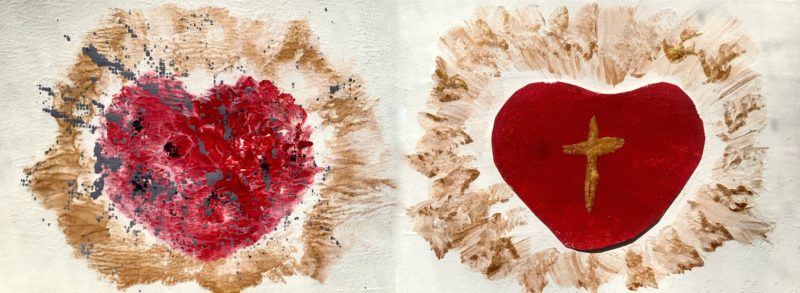
Holy Water and Baptism
“Holy Water” by Fr. William Saunders
“…holy water reminds us of our Baptism, when by the invocation of the Holy Trinity and the pouring of holy water, we were set free from Original Sin and all sin, infused with sanctifying grace, incorporated into the Church, and given the title son or daughter of God. In making the sign of the cross with the holy water, we are mindful that we are called to renew those baptismal promises of rejecting Satan, all his works, and all his empty promises, and to profess our credal faith. Once again, we repent of sin, so that we can offer our prayers and worship to God with pure and contrite hearts. Just as water and blood flowed from the Sacred Heart of our Lord as He hung upon the cross — signifying the great sacraments of Baptism and Holy Eucharist, the taking of holy water and making the sign of the cross remind us of our Baptism in preparation for the reception of the Holy Eucharist.”
Source: CatholicEducation.org
“A Few of the Top Uses of Holy Water”
Source: CatholicMom.com
“From long experience I have learned that there is nothing like holy water to put devils to flight and prevent them from coming back again. They also flee from the Cross, but return; so holy water must have great virtue. For my own part, whenever I take it, my soul feels a particular and most notable consolation.” – St. Teresa of Avila
“When I read this quote from St. Teresa of Avila, I was reminded of the importance of holy water. I think that most of the time we take holy water for granted. This water is blessed by GOD! It can banish demons, heal the sick, and send unwarranted grace upon us, and yet most of the time I just cross myself with it without even thinking. The fact of the matter is that holy water is a powerful sacramental and we ought to use it daily. Here is a list of some important ways to use holy water in your everyday life.”
“Bless yourself * Bless your house * Bless your car * Bless the sick”
Meet a Young Saint
Saint’s Day, October 1–Saint Therese of Lisieux
“St. Therese believed that the people of her time lived in too great fear of God’s judgment. The fear was stifling and did not allow people to experience the freedom of the children of God. St. Therese knew from her life that God is merciful love; many scripture passages in the Old and New Testaments bore out that truth. She loved the maternal images for God in the Old Testament and the love of God for us in Jesus Christ. In fact, St. Therese once wrote that she could not understand how anyone could be afraid of a God who became a child. She also knew that she would never be perfect. Therefore, she went to God as a child approaches a parent with open arms and a profound trust.”
Source: LittleFlower.org “St. Therese and Her “Little Way”
A Video from Catholic.org of Saint Therese de Lisieux
“Therese’s “little way” of trusting in Jesus to make her holy and relying on small daily sacrifices instead of great deeds appealed to the thousands of Catholics and others who were trying to find holiness in ordinary lives.”
Source: Catholic.org
Art Project Method and Materials–“Roses for Saint Therese of Lisieux”
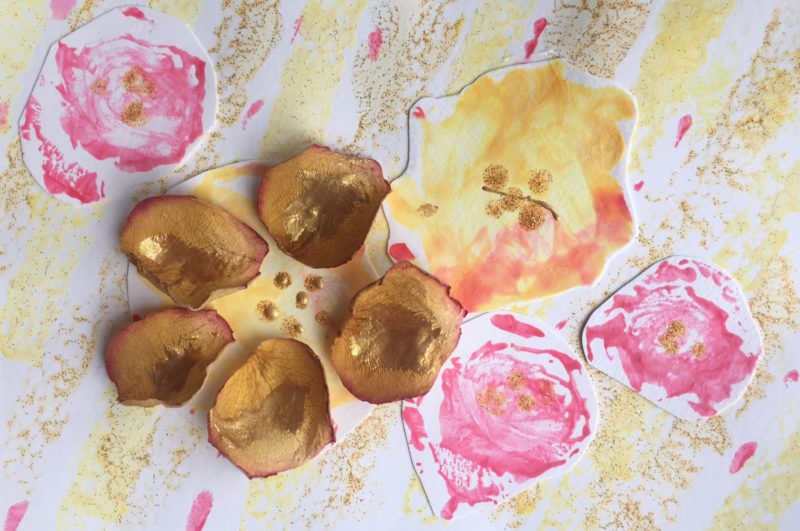
Art Project Method and Materials–Paschal Candle
I almost always use watercolor paper for most of my paintings because it it strong and absorbent. This is an extravagant project because I started by dipping cut string, greater in length than the paper, into liquid acrylic paint and placing it onto the paper to make lines. I like that the lines are straight and different from another, each time. It is fun and goes fast. I cut out my “candle” from another piece of watercolor paper, then placed it vertically onto the paper I was painting to maintain a blank place. First, I painted the candle- to- be with white liquid acrylic paint mixed with liquid glue in same amounts and let dry a bit. Then, I decorated the “candle” piece of paper with the several symbols of a traditional Paschal Candle—Alpha and Omega symbols– and crosses, using liquid acrylic paint. When dry, I glued it onto the larger, string-painted paper, officially making this painting a collage. This is where it becomes extravagant. I decided to use the fabulous, kids’ gold metallic paint (fume-free), and a small, sponge paint brush to make all the gold lines on the paper and around the glued down candle. Then I used red acrylic paint in a tube to smear a glowing “halo” above the candle with my finger. Next, I smeared gold paint onto the red. My crowning glory was using a dried rose petal smeared with a bit of gold paint to enhance the flame. If you don’t happen to have a dried rose petal, cut one out of paper and paint it. That should work well, too, for the flame.
Suggested Homework Activities–Week Three
Please read “The Parable of the Young and Foolish Women” on the USCCB.org or in a family Bible, Matthew, chapter 25:1-13, with your child. You may also read the story in a Catholic Children’s Bible.
Invite your child to draw or paint a Paschal candle. Be sure to decorate with the year, crosses, and the Alpha and Omega symbols. The Alpha and Omega letters are Greek and mean, “The beginning” and “The end.” Christ is both. He is eternal.
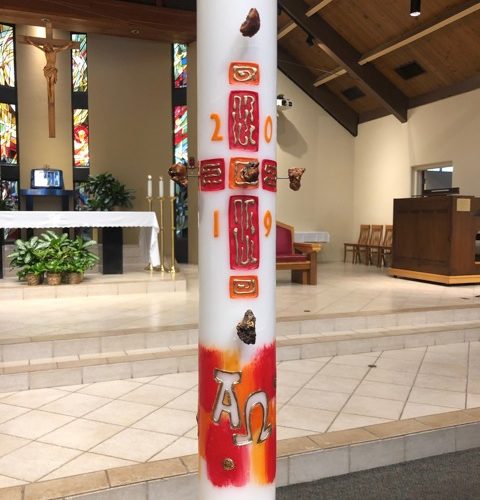
Have your child draw or paint a Chi Rho, which is an early cross. Here is an example from an ancient church in Jerusalem:
